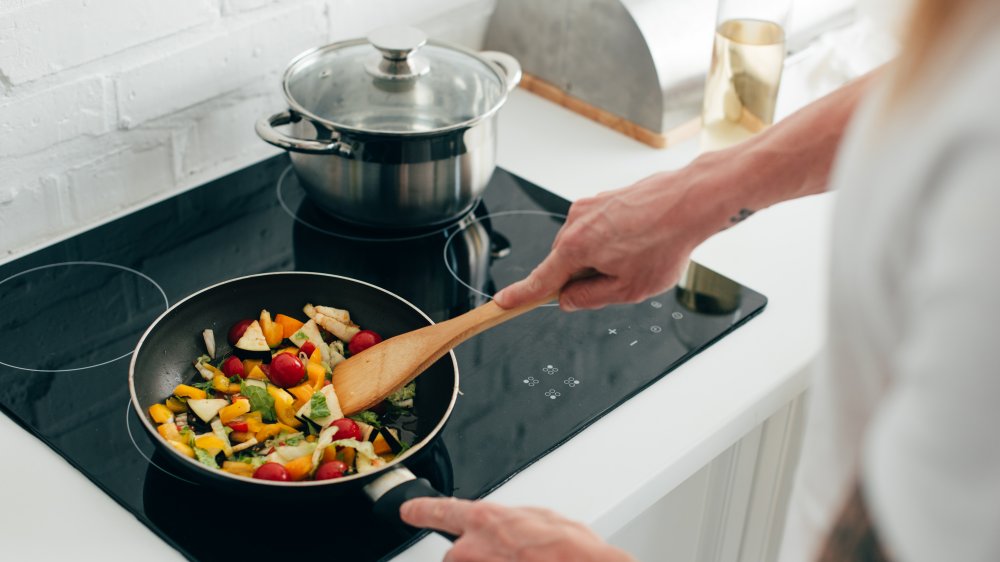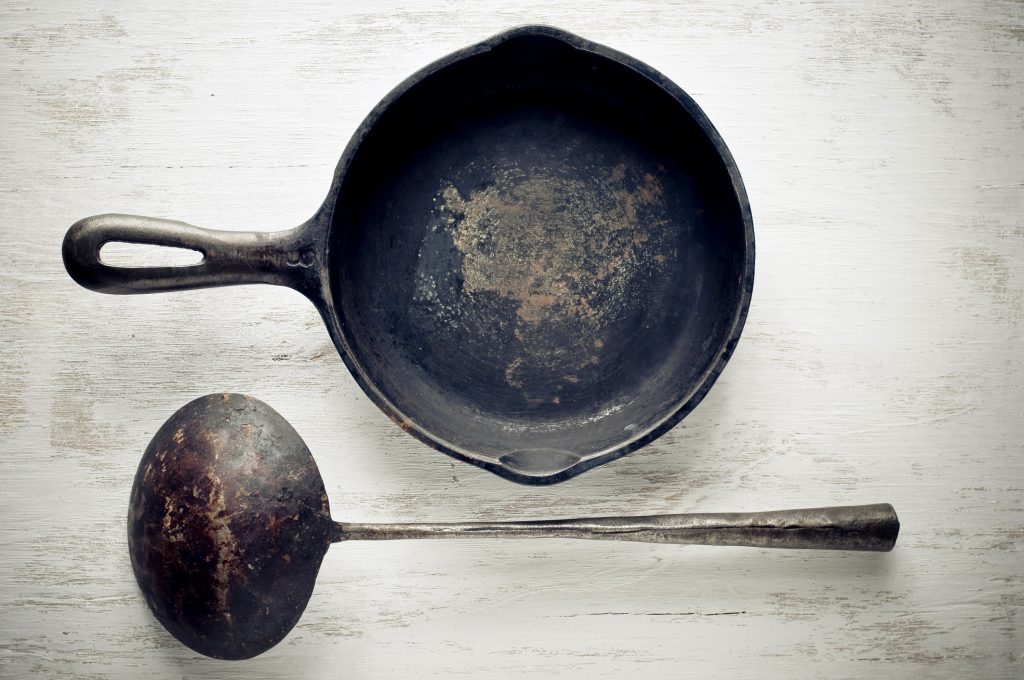Table of Contents
 It’s easier to stock up on Non-Stick Pans than throwing them away when the need arrives. Chances are you’re still weighing your options thinking, “Is it really the time to say goodbye to my Non-Stick frying Pan?”
It’s easier to stock up on Non-Stick Pans than throwing them away when the need arrives. Chances are you’re still weighing your options thinking, “Is it really the time to say goodbye to my Non-Stick frying Pan?”
If that’s the case, then you aren’t alone in your struggle. In fact, most people do not know when their Non-Stick is better in the dump than being in their kitchen.
Investing in a Non-Stick Pan is rather expensive than investing in other kitchen gadgets and for a very good reason. Not only does the Non-Stick cookware prevent food from sticking to its surface but also makes cleaning relatively easy.
This is perhaps one of the reasons why some people feel reluctant in throwing their Pans away. However, it leads to some consequences if you choose to continue using your Non-Stick Pans that aren’t supposed to be used anymore.
Concerns Regarding Non-Stick Cookware
You might be surprised, but Non-Stick Pans and pots have been around for more than the past 5 decades. To this day people often prefer having Non-Stick over other forms of cookware.
However, with its increasing popularity, the usage of Non-Sticks has always been under quite a debate.
Non-Stick cookware comes with a coating, known as Polytetrafluoroethylene or in simple words, Teflon. According to some people, the coating of Teflon can prove to be quite dangerous and toxic for health. However, smaller bits, if consumed, are not as dangerous for health and nowhere near where it threatens your precious life.
Poor quality of Non-Stick Pans can have issues like the coating of Teflon coming off like flakes. This issue can also occur if the Pan is not being handled carefully.
Metal cutlery if used on Non-Stick cookware can make the matter even worse. If you use a metal spoon or spatula against the surface to scrape the food off the Pan, then the Non-Stick Pan can lose its coat resistance capabilities.
Furthermore, Some Non-Stick cookware also features a coating of fluoropolymers. This coat starts degrading over the temperature of 500 °F. Although the coat isn’t particularly dangerous for health, it does release a fume called fluorocarbon in the air.
Just like the coating, Fluorocarbon is not dangerous for health, but it can temporarily cause flu-like symptoms in humans.

When Should You Throw Away Your Non-Stick Pans?
Usually, when your Non-Stick Pan has been at your service and cannot serve you any longer, it gives you signs. Here’s how you can interpret the signs once you see them.
1) Your Non-Stick Pan Has Scratches On It
Scratches on your Non-Stick Pan is a clear warning that the Pan is not being handled correctly. Although the scratches themselves aren’t much of a big deal, however, the coating that chirps off from the Pan due to the scratch is what makes your Non-Stick Pan lose its properties.
The base of some Non-Stick Pans is usually covered with Teflon. This coat prevents your food from bonding with the base, hence making it a “Non-Stick” Pan. However, if the coating starts flaking then it can prove to be bad for your health.
2) Signs Of Warping Found On The Pan
Pans can warp over a period of time. Warped Non-Stick Frying Pans aren’t usually bad for health, but they can directly affect the quality of food that you cook on them.
Wrapped Pans usually have an uneven base that cooks your food in an uneven manner. This can leave you with your food being undercooked from one side and overcooked from the other.
To save yourself from the hassle and possible future embarrassment, you should dispose of your Non-Stick Frying Pans.
3) The Surface Of Your Pan Has Discolored
Food can cause discolouration on your Non-Stick Frying Pan. Pans usually get discoloured over time due to the buildup of food, especially by the residue of oil.
Non-Stick Pans are usually designed in a way that oil is specifically not required for the purpose of cooking. However, the use of grease and oil leaves its residue on the surface of the Non-Stick Pan.
Although the change of color means no harm, however, it means that the base of your Non-Stick Pan is possibly damaged.
4) Can Your Non-Stick Pan Last Forever?
No! Your Non-Stick Pan cannot last forever. Unlike cast iron, Non-Stick Pans do not have life-extending properties. At most, Non-Stick can give you 5 years of its useful life.
Proper maintenance is the key in order for you to get the most out of your Pan. Here’s what you can do to maintain the quality of your Pan
- Sharp utensils and metal can permanently damage your Pan, therefore avoid using them
- Avoid the sudden temperature change of your Non-Stick Pan
- Clean the surface of your Non-Stick Pan with sponges or scratch-proof cleaning pads
- Avoid using your Pan for the storage of food
- Wash and properly dry your Pan after every use
- Avoid heating your Non-Stick Pan above the recommended heat by the manufacturer

Can You Repair Your Non-Stick Pans?
A Non-Stick Pan with declining Non-Stick properties is definitely a cause of concern. Here a question arises, can you really revive your Non-Stick Pan? Well yes, you can, however, not in all instances. The process of repair actually depends on the condition of your Pan.
If your Non-Stick Pan has slight flakes of Teflon coat coming off from the surface then here’s what you can do to revive your Pan.
Solution #1: Season Your Non-Stick Pan With Coconut Oil
Seasoning your Non-Stick Pan with coconut oil helps in the process of recoating the surface of your Pan. All you need to do is
- Put your oven on preheat at a temperature of 300° F to 340° F
- While the oven is on preheat, heat your Pan using the stove at a temperature where you do not end up burning yourself while applying oil at the base.
- When the Pan reaches a suitable temperature, apply a layer of oil. Make sure the layer is not too thick
- Once the layering is done, put the Pan in the oven for at least 1.5 hours and 2 hours at max.
- After 1.5 or 2 hours turn off your oven but do not take out your Non-Stick Pan. Let it stay in the oven overnight
- You can take out your Pan on the day and your Non-Stick Pan will be as good as new.
Solution #2: Reviving The Surface With Cookware Repair Spray
- Put the oven on preheat at a temperature of 500 °F
- While the oven is on the preheating process, make sure your Non-Stick Pan is washed and dried properly
- Once the surface of the Pan is clean, apply a thick and even coat of cookware repair spray.
- Make sure the spray covers the inside of the Pan properly and evenly. Once done, let your Pan rest for 30 mins
- Now put your Pan in the oven for 45 minutes. Once done, let the Pan still in the oven till it cools off completely.
- You can start using your Non-Stick Pan again after thoroughly washing your Pan with a soft sponge.
Bottomline
Now we hope you know what to do with your dirty old stick Pans and a number of ways to repair it! Stay healthy and make your stick Pan last as long as possible!